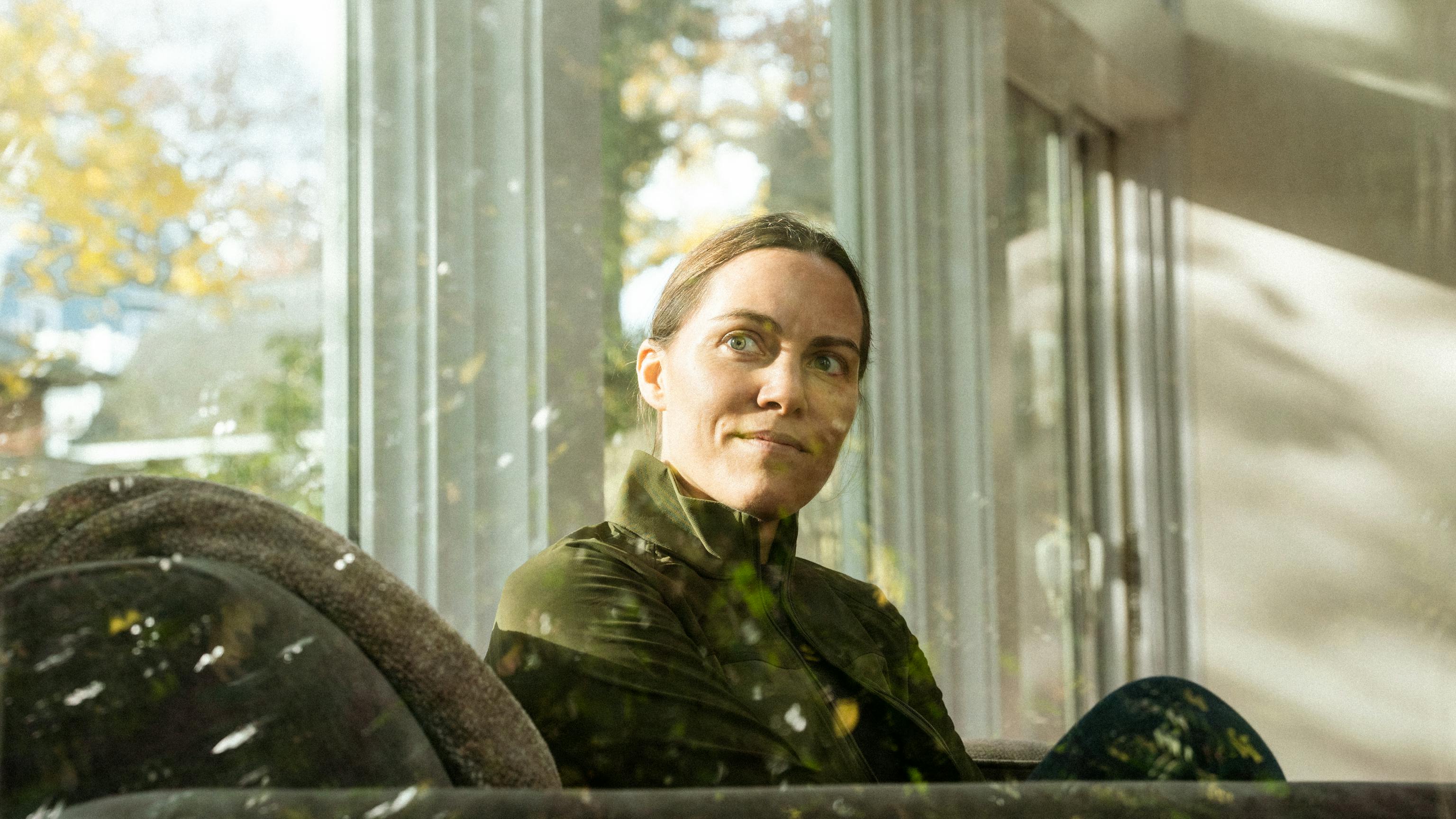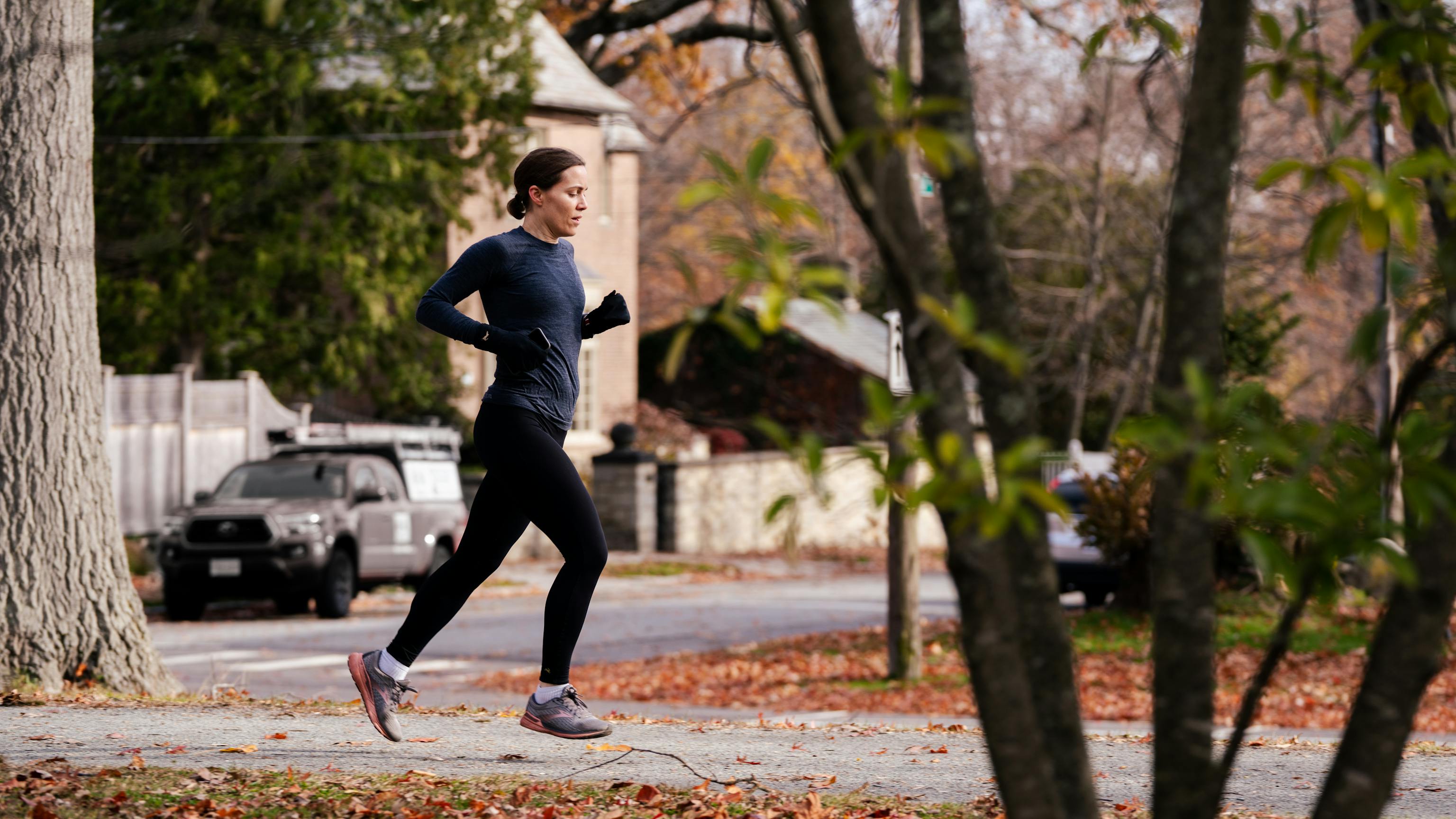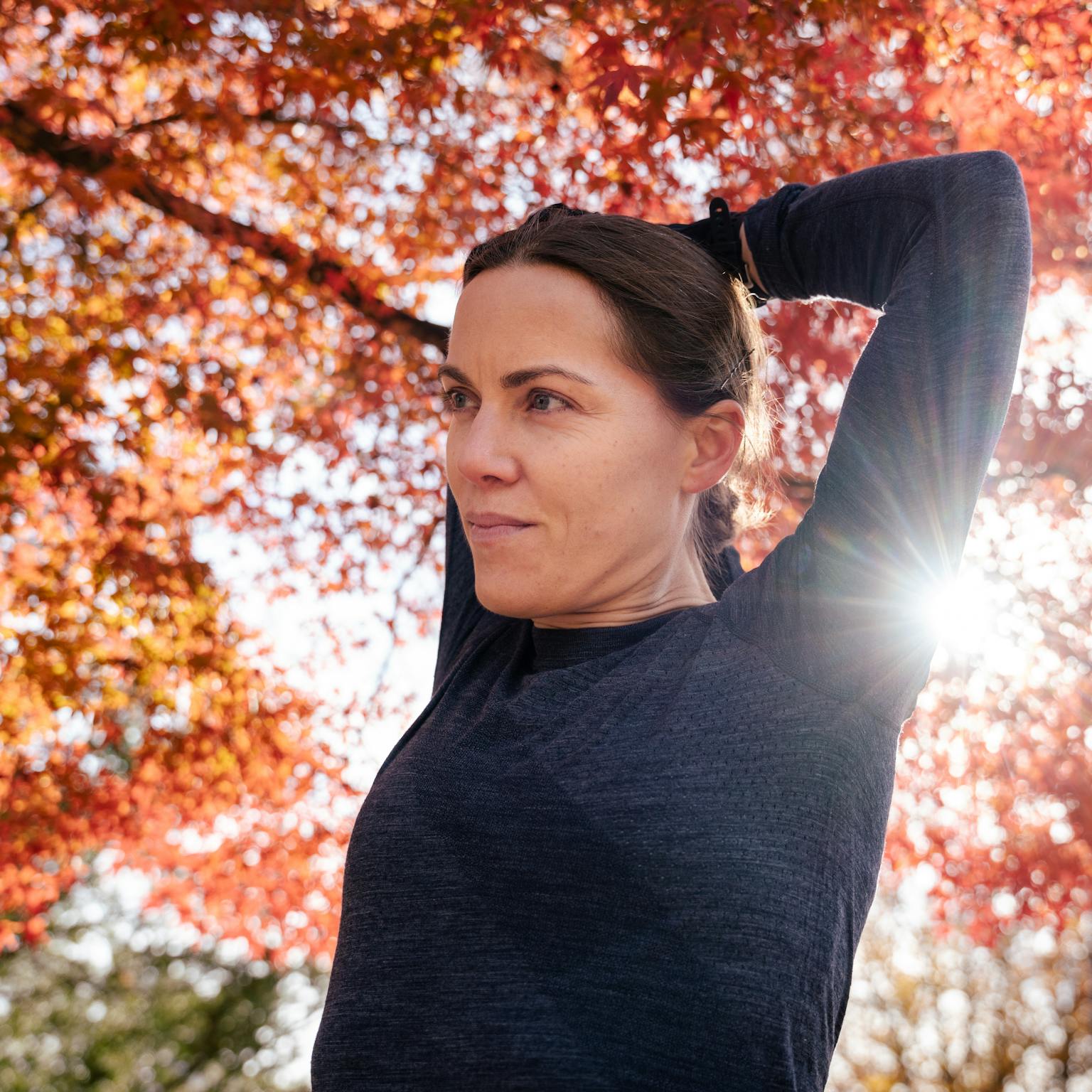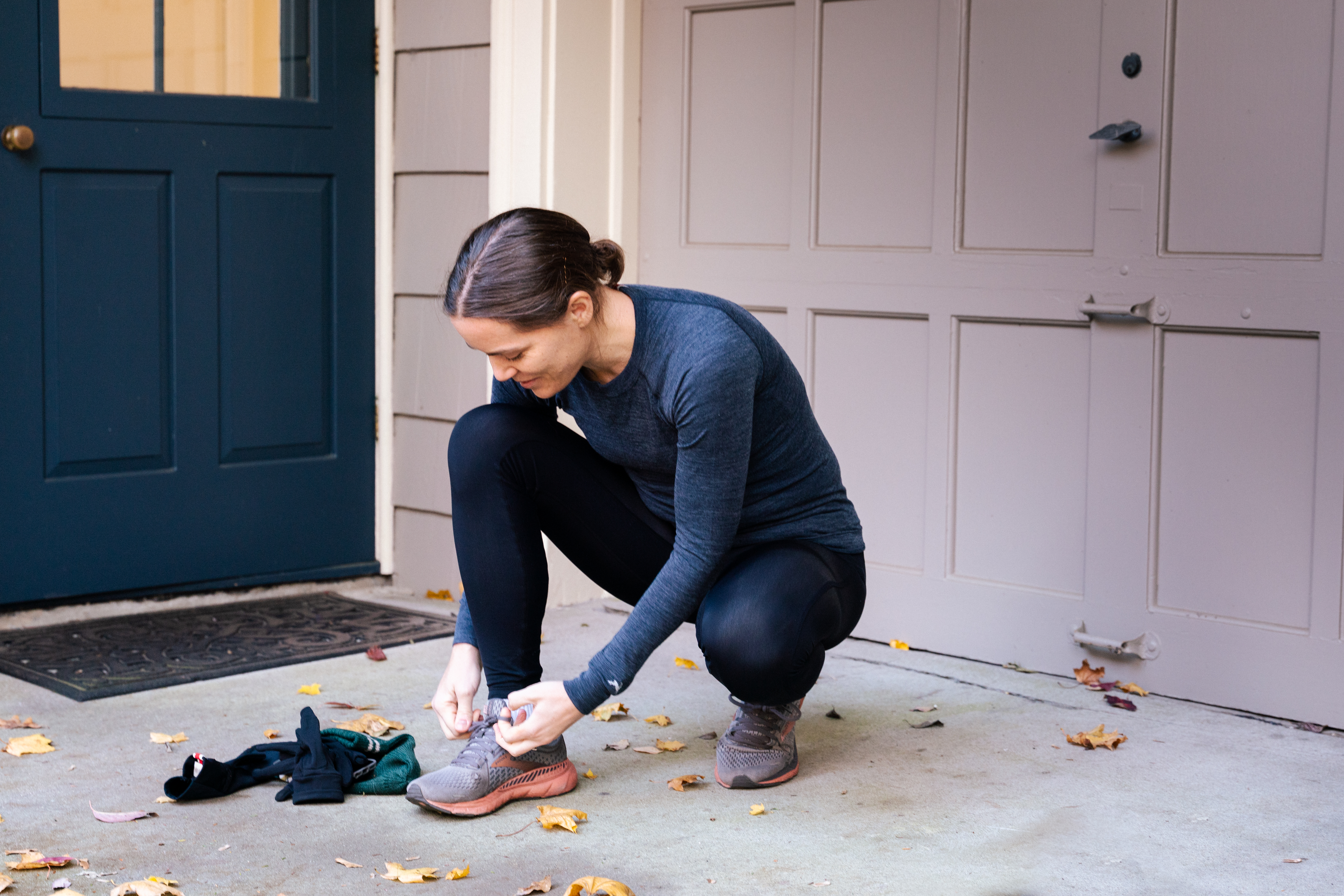
Emily Oster:
Through the
Looking Glass
Words by Amory Rowe
Photography by Aisha McAdams
Sushi during pregnancy? Fine.
How about coffee? Also fine.
Breastfeeding? Not the slam-dunk panacea we’ve been led to believe.
Screens? In moderation.
Spanking? No.
Vaccines? Yes.
Kids in school? Oh, yes. Definitely yes.
These are several of the thorny questions navigated by economist, professor and author Emily Oster since the 2014 publication of her bestselling book “Expecting Better.” She has subsequently published two more – “Crib Sheet” (2019) and “The Family Firm” (2021) – while also stepping confidently into the maelstrom of public opinion as an early advocate for reopening schools during the pandemic.
Ask Emily Oster if she’s an economist or a teacher first, and she’ll tell you: “At this point, a lot of people would say that I’m a writer.” The truth is that Oster is a trained economist and tenured professor, who became a trusted parenting expert by debunking long-held myths about pregnancy and child-rearing, and then jumped the fence into the field of epidemiology when she took vocal positions on the effectiveness of school mask mandates and the dangers of school closures during the pandemic. “I’m always out of my lane,” Oster confessed in an interview with the New York Times earlier this year.
Whether delivering a considered verdict on topics ranging from pacifiers to paid parental leave, or wading into the politicized swamp of pandemic protocols, Oster’s methodology remains consistent: she’s devoted to the data. “The kind of work I do is data-forward,” she explains. “It takes the perspective that we can use data to learn about the world.”
Oster follows the data the way Dante follows Virgil through the Inferno, except she contends not with pagans and sinners, but with fiery teachers, incendiary school board meetings and parents melting under the pressure of at-home learning. In fact, much of what allows this economist, who self-describes as lacking a thick skin, to stand in the white-hot glare of at the center of an epidemiological debate is her cold hard faith in the numbers.

Notably, the only time Oster is data-agnostic is when she’s running. Even in this day and age of Garmin, Whoop, Oura, Apple and Strava, when you can track every mile, minute, heartbeat and calorie, Oster keeps it simple. She runs five to 10 miles a day, usually in the early morning, which this time of year means lacing up her Brooks trainers in the dark. While she wears a Garmin Forerunner and has a Strava account, she runs under a pseudonym to protect her privacy and doesn’t pay much attention to the numbers. “Running is a form of self care,” Oster explains. “It’s sort of my escape.”
Oster’s relationship with running stretches back to early childhood. She grew up in New Haven, Connecticut, the oldest of three children. Both of Oster’s parents earned their Ph.D.s in Economics – from MIT and Harvard – and took positions on the faculty at Yale. Oster’s mother, Sharon Oster, was the first woman to earn tenure at Yale’s School of Management and was its first female Dean; and Oster’s father, Ray Fair, may be the Dan Marino of Economics: the game’s most talented practitioner yet to win its biggest prize. Fair is also an avid runner.
When the pinnacle of achievement in your household is set as high as a Nobel and includes the shattering of Ivied glass ceilings, family members tend to get comfortable with the grind and strive of it all. The Oster/Fair family learned early how to flex their competitive muscle by making an annual habit of running the New Haven Road Race each Labor Day. Father Fair has completed all but two of the last 40 iterations of the 20k, while his children tested their adolescent mettle in the 5k.
“I ran as a little kid all of the time,” recalls Oster. All the siblings did. “We have a picture of my brother, who is a couple of years younger than me. He must have been four. He’s crossing the 5k finish line, stopping his watch. You can see the level of competitiveness.” (Perhaps unsurprisingly, that fierce four-year old has gone on to post a 2:37 marathon PR and recently put a toe in the water of ultra running at the storied Leadville 100.)
As Oster grew up and began achieving academically, she continued to rely on her daily run as a counterweight to mounting pressure. “From a pretty young age, it has always been something that I could do to reset,” she states. “It’s a weird memory – I must have been 13 or 14 – but there was some award that I wanted to win at my eighth grade graduation. I remember being very anxious about whether I was going to win it. And I remember running that morning in the pouring rain. Basically being like, the way that I'm going to deal with this anxiety is I'm going to go running.” Was it her antidote? “It was,” she says, “and it definitely still is.”

When you consider all of the hats Emily Oster wears – author, economist, professor, parent, partner – it’s no surprise she’s a runner. The sport magnetizes those who are invested in time optimization. Even her running stride – short, quick and practiced – is a portrait of efficiency. She’s deceptively swift. Watching Oster churn out miles on a straight stretch of trail near her home, one gets the sense she could be running an all-out 5k or at the 20-mile mark of a marathon and you wouldn’t be able to tell the difference.
Outside the confines of her daily run, Oster moves through the world with similar speed, clarity and purpose. Over the course of the past decade, life in the household she shares with her husband and two children has accelerated exponentially, with the last 18 months of the pandemic representing the sharpest climb yet.
Imagine for a moment that you could speed up your life the way we can speed up an audiobook – not to an absurd Alvin-and-the-Chipmunks degree, but a nudge to 1.2x or 1.3x your normal rate of accomplishment. This is the speed at which Emily Oster is living. It's not immediately noticeable, the way it's not immediately apparent how fast Athing Mu is running the third 200m of an 800m race; it’s only when a space yawns open between her and the pack of talented athletes in her wake that the penny drops. Once you study Emily in relation to others, you understand how quickly she's moving through the world.
On January 1, 2020, Oster posted to Instagram a fittingly data-driven reflection on the decade just ended: “I am not sure I will have another decade quite like this: 2 kids, 2 books (250,000 copies!), 18 publications, 2 houses, 5 moves, 2 promotions, 1 (epic) tenure denial, 1 tenure approval.” It’s a stunning list of accomplishments. But less than two years – and a pandemic – later, Oster can already add to that list: a third New York Times bestselling book; several publications in The Washington Post, The Atlantic and the aforementioned New York Times; features in Rolling Stone and The New Yorker; countless high-profile interviews, including one with Hillary Clinton; the creation of a nationwide COVID school data hub; and least quantifiable but perhaps most valuable: the tested ability to serve as a font of wisdom through the nightmare of parenting during a multi-year pandemic.

Despite serving as a lightning rod for critics, Oster brings a cool pragmatism to her work. Sitting at her kitchen table at her home in a leafy section of Providence, Rhode Island, Oster fields questions with the earnestness of a student and the conviction of a professor. She leans forward when discussing her work and tilts back when answering more personal questions, perfectly balanced on a fulcrum of her own design. Always, though, she keeps her shoulders square to her interrogator and her blue-eyed gaze set straight ahead.
Whether you think Oster is “a hero [or] a villain,” as the New York Times put it in the title of its June 2021 piece on Oster’s fight to reopen schools, you have to admire her courage – and her optimism. Runners are a hopeful bunch by nature. We’re hard-wired to believe our best run might be our next run and we deploy our daily effort as a bulwark against what Lincoln called "the silent artillery of time.” Oster extends that buoyancy to her professional life, often wrapping hard truths about school dropout rates and long-term pandemic impacts in an upbeat “We Can Do It” demeanor. She’s a crazy-smart, 21st-century Rosie the Riveter in running tights.
Part of what accounts for Oster’s optimism is the degree to which she is grounded in her family. “My kids, my husband, they couldn’t care less about this stuff,” Oster says by way of explaining her ability to handle the recent onslaught of criticism. “My husband is not a very public person. He’s not on Twitter. He’s not on Instagram. He doesn’t really understand how they work.”
Though Oster deploys her organized systems and data-driven frames in their shared home life – she rarely encounters a small-scale challenge that can’t be solved with a Google sheet, a calendar reminder and a checklist. She and her husband work hard to keep the public out of their private lives. The only time in recent memory when they’ve relaxed that boundary was when Oster’s husband, Jesse Shapiro – also a Harvard-educated professor of Economics at Brown – was named a MacArthur Fellow. As part of the announcement of the 2021 awards, unofficially known as “genius grants,” the MacArthur Foundation asked to photograph Shapiro at work in his home office. Oster and Shapiro allowed it just that once. Some rules – even the most considered ones – are meant to be broken.
Despite their shared affinity for living a deliberate life, Shapiro still holds the honor of engendering what Oster says is one of her most genuine moments of surprise. He was living in Chicago teaching at the Booth School of Business and Oster was finishing up her Ph.D. in Boston. She flew West to visit him and he picked her up at the airport and drove her to his new apartment in a building that housed graduate students. When they got off the elevator and walked down the long hallway to the door of Shapiro’s apartment, Oster was amused to find a sign on the door that said, “WILL.” She privately remarked on the immaturity of that crop of business school students and wondered who Will was, until they entered the apartment and Shapiro walked her to a second door on which was posted a sign that read: “YOU.” Two more doors, two more signs and one immediate and affirmative answer and the rest is history. If, as Oster has said, an economist is defined by their ability to ask good, timely, relevant questions, then Shapiro has proven himself, yet again, to be the class of the field.

Oster and Shapiro used to run together: just a few miles a day a few times a week, after they got their kids off to school. But the pandemic changed that. Within weeks of the world effectively shutting down in the spring of 2020, Oster began gathering data on COVID’s impacts on children, schools and communities. By early May of 2020 she’d launched a website with longform answers to some of our earliest questions about the virus: who was most at risk? How was the virus transmitted? Was anyone immune? She followed that up with a COVID decision-making framework and, a month later, published a widely-read piece in The Atlantic titled “Parents Can’t Wait Around Forever,” in which she outlined what was known, what was “kind of” known and where we still needed more data with respect to the reopening of schools.
Oster isn’t pugnacious by nature – she refers to herself as “highly sensitive” – and she wasn’t spoiling for a pandemic fight. But she is committed to wrapping her arms around the most complete set of data she can gather and then subjecting that information to rigorous analysis. When she did that in a May 2021 study using data from schools in Florida, Massachusetts and New York, Oster and her co-authors concluded that there was no evidence that mask mandates and physical distancing in schools lowered virus transmission among students and staff. People on both sides of the masking debate howled. Some called her “dangerous”; others said she was “a blessing.” She’d say she’s a pragmatist.
As Oster moved from the outer rings of the COVID debate ever closer to the red-hot center, and as she continued to advocate for data-driven solutions to reopening schools safely, she found herself more frequently in the crosshairs of people’s ire. She also began to run more. Unhitched by circumstance from her running routine with her husband, she began running more miles, more frequently than ever before. Her morning run was the saucer that cooled the increasingly scalding conditions within the teacup of her work.
While her mileage crept up and Oster felt her average pace quicken, she took care to quiet the part of her brain that loves to use charts, graphs and spreadsheets to codify progress. “I don’t track much other than how far and what the time is,” she explains. “I'm trying very actively to not try to achieve things. Because in every other aspect of my life, I'm always trying to achieve things. And so this is a place where I would like very much to just recognize it for what it is, which is something that I enjoy. And not a place where I have to be fast.”
As hard as it is to believe, if you are a runner – the kind of runner Emily Oster is – sometimes the data ceases to be important. You are committed to the work itself. You’ve puzzled out the equations that balance pain and discomfort, effort and endorphins, and you’ve concluded that the run is your chosen tool. It checks all the boxes without the fuss of black-lit rooms, toxically positive instructors, gym cards or extraneous equipment. The simplicity of the run isn’t a bug. It’s the feature.
Does Oster know how fast she is? She’s pretty sure she ran a 5k PR in fall of 2020. Has she ever tried a carbon-plated supershoe? Never heard of ‘em. How about three adjectives that best describe her? Oster comes up with two right away: “Driven. And brave.” Then she pauses. And laughs. “Tired,” she confesses. It seems a wholly accurate self-assessment of a hard-working economist. A teacher. A parent. And a runner.
